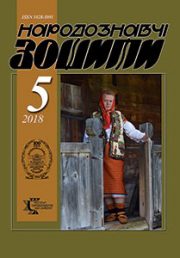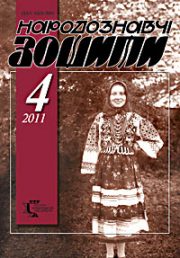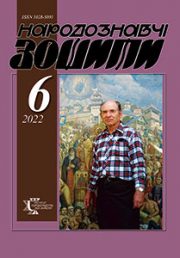The Ethnology Notebooks, 2018, № 5 (143), 1246—1254
UDK 7.033.2:7.046:7.45
DOI https://doi.org/10.15407/nz2018.05.1246
Received 16.08.2018
KNOTS ON VEILS AND KNOTS ON COLUMNS IN BYZANTINE ART: ORIGIN, USE, SYMBOLISM
ORCID ID: https://orcid.org/0000-0002-7411-0574
Matveeva Julia Genadiivna, a candidate of study of art,
associate professor
of department, is a design and fine art
The Kharkiv national university of municipal economy
of the name of О.M. Beketova
61002, Kharkiv, Kulykivs’kyi lowering, 12, Ukraine
Contacts: e-mail: matveyevoy@gmail.com
Abstrakt. Byzantine knots on the columns are common in the art of the XI—XIV centuries. Their origin was associated with the Hercules knot and Byzantine curtains. The questions which have remained unexplored are why and how a curtain on the image reduced to a knot and why this motive remains relevant in art only from the XI to the XIV century. The article reveals the process of curtains being transformed into columns with knots. The type of the knot used for veils tying is displayed based on the analysis of images. Models of knots` tying and their transformation into columns are developed. On examples of models it is proved that knots on the columns originate from the visual form of the ciborium column to which two veils from both sides were tied with the common knot. It is shown how it changed the appearance of the column: looking from top to down one could see the capital, two vertical stripes of the curtains, the knot and again the two stripes of the curtains. This visual image was the reason why the images of a dual column with a knot in the middle appeared. The image is gaining importance and relevance from the XI century because of the evolution of liturgical veils. At this time, the process of turning the curtains into big aers is undergoing .The curtains in this regard lose their function and remain permanently open — tied to columns. This causes them to be transformed into symbolic images of a dual column with a knot. At the same time, the functions of the ciborium are transferred to the altar barrier — the iconostasis develops and the ciborium lost its importance. In this process, double columns with knots begin to be used in the altar barrier and the iconostasis. By the XIV century the memory of knots on curtains had disappeared completely, knots are used as decorative elements and understood differently — they turn into the columns of entrance to the Solomon’s Temple and are located outside.
Keywords: iconostasis, curtain, veil, ciborium, knotted column, airs.
REFERENCES
German, Konstantinopol’skiy, svt. patriarh. (1995). Skazaniye o tserkvi i rassmoteniye tainstv. Moscow, MA: Martis [in Russian].
Doseva, I. (2003). Kolonite s «vezli» – opit za interpretatzija. In Problemi na izkustvoto. Trimesiachno spisanije za teorija, istorija I kritika na iskystvoto. Art Studies Quarterly, 36 А. Sofia, ΜΑ: Institut na iskustvoznanije pri Bulgarska academia na naukite, 15—19.
Lozanova, R. (2003). Liturgicheskije tkani. In Xristianskoje iskusstvo Bolgarii. Exebition 1 October — 8 December 2003. National Historical Museum, Sofia; State Historical Museum, Moscow, 59—64 [in Russian].
Matveyeva, J. (2018). Mova tkanin u vizantijskomu musteztvi. Kharkiv, MA: HNUMG imeni O.M. Beketova [in Ukrainian].
Matveyeva, J. (2015). Izobrazitelnije liturgicheskije tkani IV—XVI vv.: evoluzija v obihode I simvolike. In Lintula: sbornik nauchnih statey: materiali nauchnoj konferenzii VIII Lintulovskih chtenij 2014, 8. Sankt-Petersburg, ΜΑ: KultInformPress, 199—222 [in Russian].
Popova, O.S. (2003). Vizantijskiye I drevnerusskiye miniatyuri. Moscow, MA: Indrik [in Russian].
Stamerov, K. (1978). Narisi z istorij kostjumiv (patr 1). Kyiv, MA: Mysteztvo [in Ukrainian].
Kalavrezou-Maxeiner, I. (1985). The Byzantine Knotted Column. Byzantina kai Metabyzantina. Byzantine Studies in Honor of Milton, V. Anactos / editor Speros Vrionis; jr. Vol. 4. Malibu, MA: Undena Publications, 95—103.
Maguire, H. (1998). Rhetoric, Nature and Magic in Byzantine Art. Aldershot; Sydney.
Mathews, T.F. (1971). The Early Churches of Constantinopole: Architecture and Liturgy. University Park, MA: Pennsylvania State University Press.
Evans, H.C., & Wixom, W.D. (Eds.). The Glory of Byzantium: Art and Culture of the Middle Byzantine Era. A.D. 843—1261. New York.
Migne, J.P. (Ed.). (1862). Patrologia curcus completes. Ser. Graeca. (Vol. 61). Paris.
Migne, J.P. (Ed.). (1862). Patrologia curcus completes. Ser. Graeca. (Vol. 62). Paris.
Migne, J.P. (Ed.). (1863). Patrologia curcus completes. Ser. Graeca. (Vol. 108). Paris.
Migne, J.P. (Ed.). (1865). Patrologia curcus completes. Ser. Graeca. (Vol. 86.2). Paris.
Kyrylivs’ka tserkva. Kyiv. (4.08.2018). Retrieved from: http://ozi.pp.ua/kirilivska-tserkva-kijiv_12120/.







